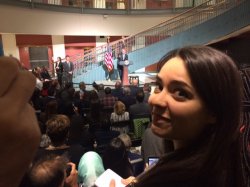Journalism Students Cover President Obama and Criminal Justice Reform
Posted in: School of Communication and Media News

According to PBS.org, “In rare bipartisan fashion, Congress is considering legislation cutting sentences for nonviolent drug offenders, an effort the White House has elevated as one of Obama’s top priorities for the remaining months of his presidency.” With movement on the issue finally taking place, President Obama put on the hat of pitchman and visited Rutgers University to speak about prison reform to elected officials, community leaders, residents and students. Among the those in attendance were Montclair State University School of Communication and Media students Gentrix Shanga, Silas Kezengwa, Juan Contla and Natalie Caamano. But, they weren’t just there as passive observers; they were reporting on the event for WiredJersey, the student run news and information website.
“It was truly an honor to cover the president,” said Kezengwa. “When President Obama came out, I immediately began taking pictures of him for our story but when he started to speak, there were moments when I had to put my camera down and just take the moment in. At any point in life this would be big but particularly now as a student with aspirations in the communication and media industry, it was extremely humbling.”
When the student’s Wired Jersey class professor, Steve McCarthy, introduced the idea of covering the President, the four jumped at the opportunity. Together, McCarthy and students wrote an email to the person in charge of press coverage for the event as instructed by the White House Press Office. After receiving the green light from the press office and approved media credentials, the students began to prepare with the help of Professor McCarthy and Professor Tara George, who originally proposed the opportunity. The mission entailed researching criminal justice reform and the President’s stance on the issue in addition to devising a plan of action for how to actually cover the story. The students watched the HBO “Fixing the System” documentary on President Obama’s visit to the El Reno federal prison, looked into articles and pulled on other resources to examine various story angles and gain knowledge on potential event interviewees.
“The research we had done before going to the event really helped us focus on what we wanted to gather when we were there,” said Shanga. “We spoke to as many legislators as we could, including NJ Senate President Steve Sweeney, Former NJ Governor Jim McGreevey, US Attorney for NJ Paul Fishman, Judge Madeline Cox Arleo as well as other legislators. We also spoke to formerly incarcerated individuals who had come to watch Obama speak in support of the movement, as well as other activists.”
Still, before the event even took place the group had to reconstruct the way they would have normally covered the story. Since all video cameras were prohibited from the venue the likely video piece was out of the question. With a bit of reassessment and strategic thinking, the students decided on covering the event as a multimedia piece featuring a predominately written work with supporting audio and video retrieved from the White House video pool.
Having been well prepared, the students took to the covering the major event like seasoned pros. Professor McCarthy recalled watching his students with a particular sense of accomplishment and pride as they shined as journalism professionals before his very eyes.
“I traveled to Newark separately and by the time I got there they had already started interviewing the NJ politicians outside the venue,” said McCarthy. “I was impressed by their taking initiative.”
What’s more, the group did not merely blend into the sea of their journalist peers, instead they set standards to be followed. Shanga and Caamano were the first to interview Dquan Rosario, a former inmate underlined in President Obama’s speech for his successful life change.
“That was such a thrilling and shining moment for the two of us because after we, the student journalists among professional journalists, spoke to him, all the media outlets wanted to interview him as well,” said Shanga. “This event was most notable because it just reinforced how prepared we as student journalists are to go into the real world and report next to the big dogs.”
The communicative four, in fact, continued to impress as they stayed up all night to produce the story for the event in which President Obama announced his Executive Action funding efforts to rehabilitate former prison inmates and remove the infamous “box” that inquires if applicants have ever been convicted of a crime from employment applications.
“Staying up all night to write the story was an interesting experience. We had talked the night before about how we wanted to structure the story,” said Shanga. “…So when we stayed up all night, we already knew what our mission was.”
And when the fire from the night of excitement began to dim and the hours began to burn, they powered through with a little extra help.
“We were up for about 22 hours,” said Contla. “Once we got back from the event we had to get dinner, but after that it was nonstop work. Next thing you know it was 6:30 am. Coffee helped.”
The experience overall has definitely been one this group will take with them in their future endeavors to aid them in their individual growth within their craft.
“Not only do I know how to be best prepared with equipment for events, but also to show up early and know who’s who because it could help land a great interview,” said Caamano.
McCarthy would be content to hear this insight as it is exactly what he intended to teach his students all along.
“I believe they got to observe some of the nation’s top journalists close up and learned, among other things, to do your homework, show up early and dress properly,” said McCarthy. “These lessons may seem obvious or trivial but they are important.”
